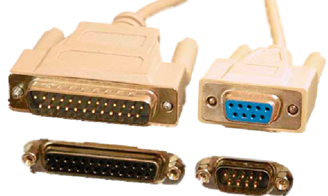Port Types: Serial, Parallel, and USB
Most systems today do not have parallel and serial ports as they have been replaced with USB 2.0 or USB 3.0. A very old system (5-10 years) may have both parallel and serial ports. These are general purpose ports designed to communicate with external devices in standardized ways. Most older systems have two serial ports and one parallel port.
Note: Some older devices may have a USB 1.1/USB 2.0.
Parallel (left) & Serial (right)

The main difference between parallel (printer/LPT port; female) and serial (COM; male) ports is the data transmission. A parallel port transmits information in chunks (all eight bits of a byte at in parallel), whereas a serial port transmits one bit after another.
Parallel ports offer faster transmission speeds but proper data transmission with parallel cables over three meters (10 feet) in length cannot be guaranteed.
Serial communication tends to be able to proof the data better than parallel (i.e., it will arrive properly and accurately). Serial cables can be quite long and are good for a system that requires the computer and plotter to be far apart.
Note: Cables and adapters are not standardized - a cable designed for a Super Adapter card will not work properly on a Roland CAMM1000. It may send data but cannot be guaranteed. If you intend to add an extension cable to an existing plotter cable, get the specs from the manufacturer or purchase the cable from the plotter manufacturer. If plotting is not working right, contact your dealer or technician and they can examine the adapter for the correct pin-outs.
USB 1.1

USB 2.0 (a & b)

USB 3.0 (a & b)

Useful Tips:
- If you are using an adapter, such as USB-Serial or USB-Parallel, ensure that the adapter is supported with your operating system as you may require drivers (found online).
- Some systems (generally desktops) have non-powered USB ports on the front of the system and powered USB ports on the back. If experiencing issues, ensure the connection is a powered USB.
- Do not connect to a USB Switch or USB hub as communication may not be consistent.
- To confirm Windows recognizes the device, use Device Manager. If the driver is not found and installed by Windows, it will show up in "Other Devices".
- If the driver is found, Windows automatically installs it in either Universal Serial Bus or Ports, depending on if it is connected USB-USB (Other Devices), USB-Serial (Ports) or USB-Parallel (Ports).
For further assistance, contact Technical Support.